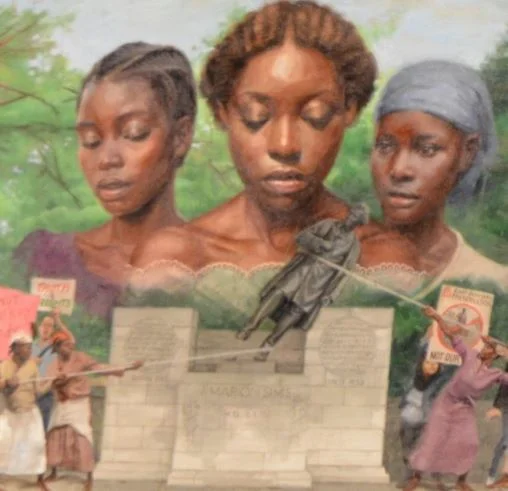Artists like Browder work to preserve their stories. So do scholars like Deirdre Cooper Owens, who immortalized their story in her book “Medical Bondage: Race, Gender, and the Origins of American Gynecology,” referring to them as Mothers of Gynecology. Browder consulted Cooper Owens’ work in creating her own.
“You can’t tell a whole history of the rise of a profession, of a medical branch, and not talk about the patients,” Cooper Owens said.
Telling a complete story also requires the acknowledgement of the practice’s beginnings — and its enduring legacy. Before Sims, there was John Peter Mettauer in Virginia, America’s first plastic surgeon, who performed the same operation as Sims, successfully on a White woman and unsuccessfully several times on an enslaved woman. He blamed his failure on the enslaved woman’s sexual nature. There was William Aiken in North Carolina, who repeatedly drilled holes in the head of an enslaved woman named Lucinda. And there was Francois Marie Prevost, who pioneered the cesarean section in Louisiana, operating on at least 30 enslaved women.
These physicians’ practices perpetuated the unfounded beliefs that Black people could not feel pain, or that they had a higher tolerance. They perpetuated attitudes that regarded Black people as disposable. The practice of experimenting on enslaved people was widespread from the late 18th century through the antebellum era.
“Sims was just a cog in a wheel,” Cooper Owens said. “There were so many ‘pioneers’ in obstetrics and gynecology, and they had almost all worked on enslaved people, and almost all of them were slave owners.”
Before the colonial period in America, midwives tended to those giving birth, applying a holistic and noninvasive approach. According to Cooper Owens, tending to mothers was a job seen as divinely ordained for women. It wasn’t until doctors like Sims came along that American gynecology was masculinized, allowing White men to dominate the field and impose paternalistic views on the women they were tasked with caring for, Cooper Owens said.
The legacy that doctors like Sims belong to endures today, rearing its head in the maternal health care crisis that places the United States among the most dangerous countries to give birth among those with comparable wealth. In a report by the
World Health Organization, North America was the only region in the world in which the maternal mortality rate was on the rise between 2000 and 2017.
As of the latest data available,
released by the Centers for Disease Control and Prevention earlier this year, Black women are more than three times more likely to die from issues related to pregnancy than White women. Black women are also more likely to have preterm births and less likely to receive adequate care.
Today’s maternal health care crisis that is killing Black women and babies is a natural continuation of the science birthed from violence, experts said. The mistreatment of Black people and their bodies has been there every step of the way.
“We didn’t get here out of nowhere,” said Dr. Veronica Maria Pimentel, an OB-GYN who collaborated with Browder. “We have to understand our history and how we got here.”
No matter the age, social status, education level, no Black woman is exempt from the possibility of a confrontation with this legacy. A
study by Dr. Fleda Mask Jackson showed that college-educated Black women still faced higher maternal mortality rates than White women who were poor, uneducated, unemployed and uninsured.
Experts attribute this to a factor called weathering, when the compounded stress of racism and sexism wears on the body. Browder cited the example of Serena Williams, the millionaire tennis icon who nearly died after childbirth when her body told her what she needed and
medical teams repeatedly ignored her.
That extends outside of reproductive health. Pimentel shared an experience in which she had to advocate for her mother, an older Black woman, who she said was not receiving adequate care. She said the care her mother received improved after she continued to speak up and her mother’s health care providers realized she was a physician herself. Pimentel said her interest in gynecology came from her mother’s belief that taking care of women takes care of society. She has started a petition to have February 28 and March 1 — the days straddling Black History Month and Women’s History Month — recognized as Betsey, Lucy and Anarcha days.
(continued)
Browder wants the clinic to be a part of a new path forward, where medical students are welcomed to come and learn.
“We want to provide a safe space where we can collectively work together and offer some solutions to end the maternal health crisis,” she said.
In Alabama, where Browder works to reclaim the legacy at 33 S. Perry Street, the need for change is urgent. In March of Dimes’ 2022 report card, the state received an F, an indicator of maternal and infant health in the state. The state’s board of health is considering regulations that would restrict midwives from working in freestanding birthing centers, which would limit access to care in a state in which the March of Dimes report deemed more than a third of its counties maternity care deserts.
“The powers that be want to dictate to you how to have your baby, after they tell you that you have no right to govern your own body. They now want to tell you how to give birth,” Browder said.



